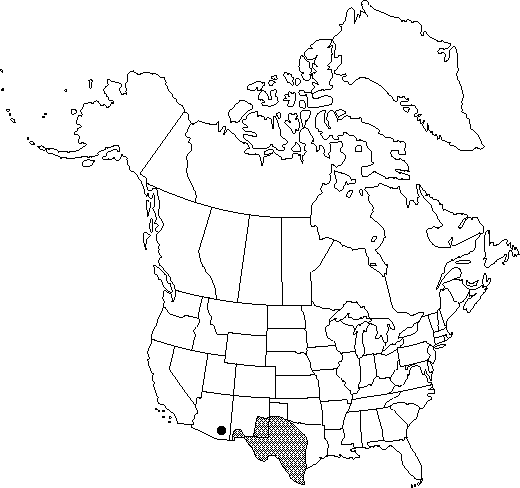Difference between revisions of "Berberis trifoliolata"
Pl. Nouv. Amér., 113. 1841.
FNA>Volume Importer |
FNA>Volume Importer |
||
| Line 24: | Line 24: | ||
}}<!-- | }}<!-- | ||
| − | --><span class="statement" id="st- | + | --><span class="statement" id="st-undefined" data-properties=""><b>Shrubs,</b> evergreen, 1-3.5 m. <b>Stems</b> ± dimorphic, with elongate primary and short axillary shoots. <b>Bark</b> of 2d-year stems gray or grayish purple, glabrous. <b>Bud</b> scales 2-3 mm, deciduous. <b>Spines</b> absent. <b>Leaves</b> 3-foliolate; petioles 0.8-5.4 cm. <b>Leaflet</b> blades thick and rigid; surfaces abaxially dull, papillose, adaxially dull, ± glaucous; terminal leaflet sessile, blade 2.3-5.8 × 0.9-2 cm, 1.6-3.1 times as long as wide; lateral leaflet blades narrowly lanceolate or narrowly elliptic, 1-veined from base, base acute or acuminate, rarely rounded-acute, margins plane, toothed or lobed, with 1-3 teeth or lobes 3-7 mm high tipped with spines to 1-2 × 0.2-0.3 mm, apex narrowly acute or acuminate. <b>Inflorescences</b> racemose, lax, 1-8-flowered, 0.5-3 cm; bracteoles membranous, apex acuminate. <b>Flowers</b>: anther filaments without distal pair of recurved lateral teeth. <b>Berries</b> red, sometimes glaucous, spheric, 6-11 mm, juicy, solid.</span><!-- |
-->{{Treatment/Body | -->{{Treatment/Body | ||
| Line 30: | Line 30: | ||
|habitat=Slopes and flats in grassland, shrubland, and sometimes open woodland | |habitat=Slopes and flats in grassland, shrubland, and sometimes open woodland | ||
|elevation=0-2000 m | |elevation=0-2000 m | ||
| − | |distribution=Ariz.;N.Mex.;Tex.;n Mexico | + | |distribution=Ariz.;N.Mex.;Tex.;n Mexico. |
|discussion=<p>The illegitimate name Berberis trifoliolata Moricand var. glauca (I. M. Johnston) M. C. Johnston has been used for plants with very strongly glaucous leaves. Weakly and strongly glaucous plants are often found in the same population, however, indicating that they are not distinct varieties.</p><!-- | |discussion=<p>The illegitimate name Berberis trifoliolata Moricand var. glauca (I. M. Johnston) M. C. Johnston has been used for plants with very strongly glaucous leaves. Weakly and strongly glaucous plants are often found in the same population, however, indicating that they are not distinct varieties.</p><!-- | ||
--><p>Berberis trifoliolata is susceptible to infection by Puccinia graminis.</p> | --><p>Berberis trifoliolata is susceptible to infection by Puccinia graminis.</p> | ||
| Line 51: | Line 51: | ||
|habitat=Slopes and flats in grassland, shrubland, and sometimes open woodland | |habitat=Slopes and flats in grassland, shrubland, and sometimes open woodland | ||
|elevation=0-2000 m | |elevation=0-2000 m | ||
| − | |distribution=Ariz.;N.Mex.;Tex.;n Mexico | + | |distribution=Ariz.;N.Mex.;Tex.;n Mexico. |
|reference=None | |reference=None | ||
|publication title=Pl. Nouv. Amér., | |publication title=Pl. Nouv. Amér., | ||
|publication year=1841 | |publication year=1841 | ||
|special status=Selected by author to be illustrated | |special status=Selected by author to be illustrated | ||
| − | |source xml=https://jpend@bitbucket.org/aafc-mbb/fna- | + | |source xml=https://jpend@bitbucket.org/aafc-mbb/fna-data-curation.git/src/9216fc802291cd3df363fd52122300479582ede7/coarse_grained_fna_xml/V3/V3_1055.xml |
|genus=Berberis | |genus=Berberis | ||
|species=Berberis trifoliolata | |species=Berberis trifoliolata | ||
| − | |||
| − | |||
| − | |||
| − | |||
| − | |||
| − | |||
| − | |||
| − | |||
| − | |||
| − | |||
| − | |||
| − | |||
| − | |||
| − | |||
| − | |||
| − | |||
| − | |||
| − | |||
| − | |||
| − | |||
| − | |||
| − | |||
| − | |||
| − | |||
| − | |||
| − | |||
| − | |||
| − | |||
| − | |||
| − | |||
| − | |||
| − | |||
| − | |||
| − | |||
| − | |||
| − | |||
| − | |||
| − | |||
| − | |||
| − | |||
| − | |||
| − | |||
| − | |||
}}<!-- | }}<!-- | ||
-->[[Category:Treatment]][[Category:Berberis]] | -->[[Category:Treatment]][[Category:Berberis]] | ||
Revision as of 14:30, 27 July 2019
Shrubs, evergreen, 1-3.5 m. Stems ± dimorphic, with elongate primary and short axillary shoots. Bark of 2d-year stems gray or grayish purple, glabrous. Bud scales 2-3 mm, deciduous. Spines absent. Leaves 3-foliolate; petioles 0.8-5.4 cm. Leaflet blades thick and rigid; surfaces abaxially dull, papillose, adaxially dull, ± glaucous; terminal leaflet sessile, blade 2.3-5.8 × 0.9-2 cm, 1.6-3.1 times as long as wide; lateral leaflet blades narrowly lanceolate or narrowly elliptic, 1-veined from base, base acute or acuminate, rarely rounded-acute, margins plane, toothed or lobed, with 1-3 teeth or lobes 3-7 mm high tipped with spines to 1-2 × 0.2-0.3 mm, apex narrowly acute or acuminate. Inflorescences racemose, lax, 1-8-flowered, 0.5-3 cm; bracteoles membranous, apex acuminate. Flowers: anther filaments without distal pair of recurved lateral teeth. Berries red, sometimes glaucous, spheric, 6-11 mm, juicy, solid.
Phenology: Flowering winter–spring (Feb–Apr).
Habitat: Slopes and flats in grassland, shrubland, and sometimes open woodland
Elevation: 0-2000 m
Distribution

Ariz., N.Mex., Tex., n Mexico.
Discussion
The illegitimate name Berberis trifoliolata Moricand var. glauca (I. M. Johnston) M. C. Johnston has been used for plants with very strongly glaucous leaves. Weakly and strongly glaucous plants are often found in the same population, however, indicating that they are not distinct varieties.
Berberis trifoliolata is susceptible to infection by Puccinia graminis.
Selected References
None.
